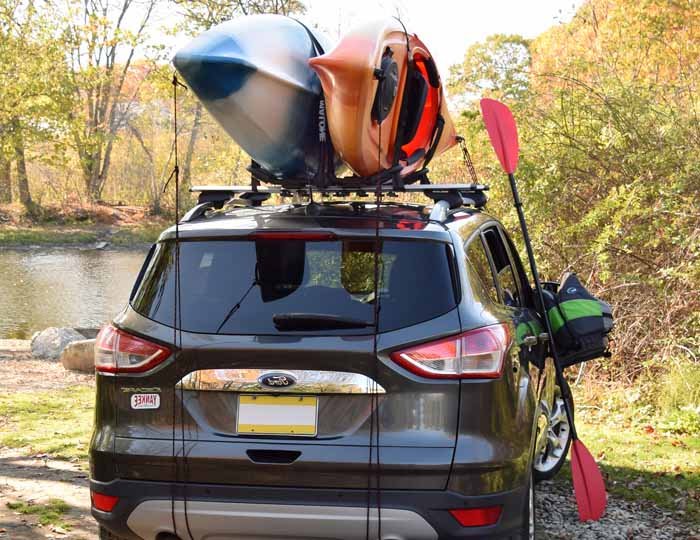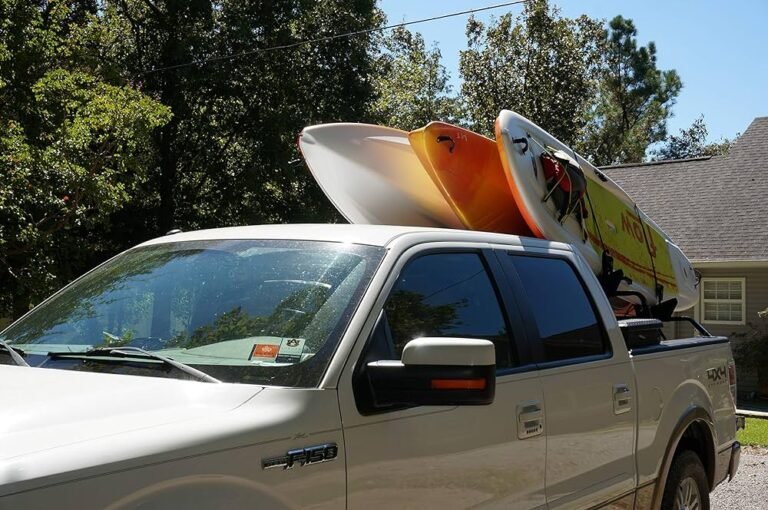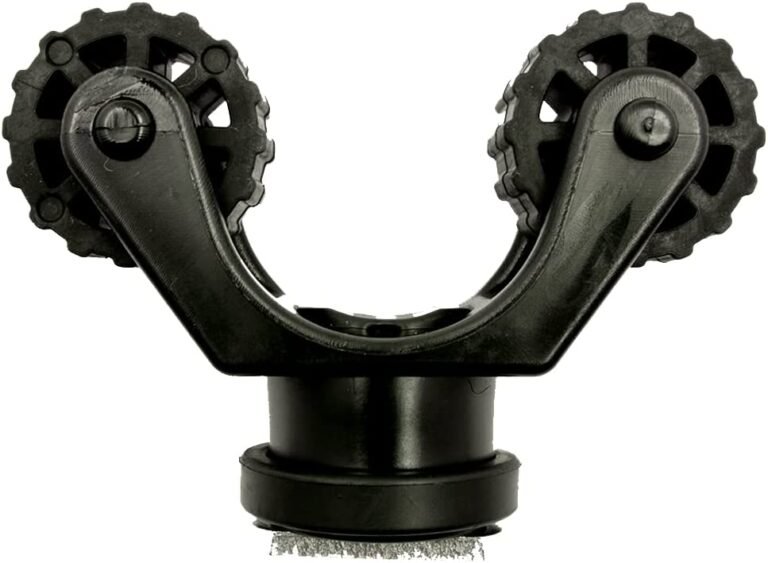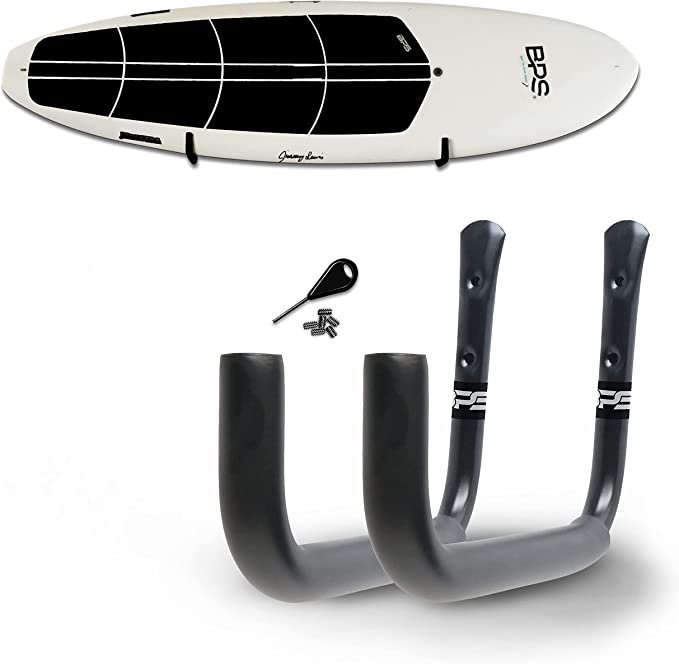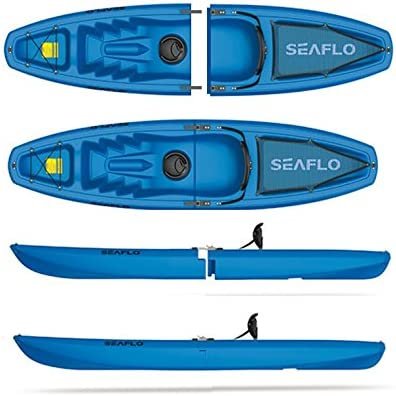How To Transport A Kayak In A Truck
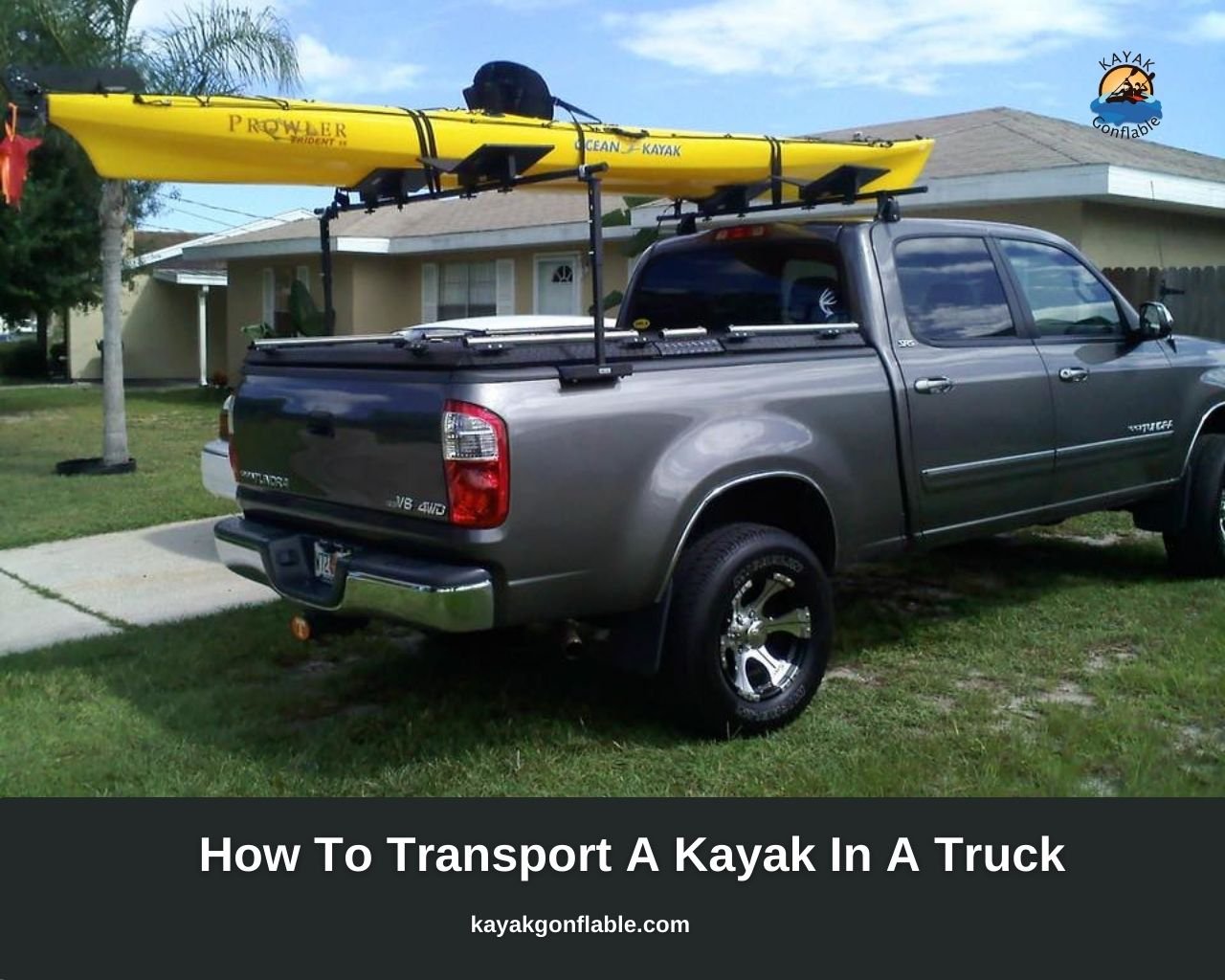
Kayaking is a famous paddle port loved and practiced by many that allows you to enjoy nature while having a workout. Kayaks are essential to the sport of kayaking and as such must be in good condition if they will keep the user safe.
Kayaks also need to be moved from one place to another sometimes miles apart as kayakers are adventurers and explorers who derive joy from exploring new environments.
The transportation of kayaks can be accomplished in several ways but a very reliable one is the use of a truck.
There are three main ways to transport a kayak in a truck: transporting the kayak on the roof of the truck with the use of a kayak rack, transporting the kayak on the roof of the truck without the use of a kayak rack, and transporting the kayak in the bed of the truck.
Whichever of the three methods you choose, certain measures are required to make the trip a safe one. Read on and enjoy!
Transporting The Kayak On The Roof Of The Truck With The Use Of A Kayak Rack
What Is A Kayak Rack?
A kayak rack is a device used to hold kayaks in place while they are being transported. It typically consists of a series of metal bars that are attached to the vehicle’s roof or trunk.
Kayaks can be hung from the bars using either straps or hooks, which allows them to be transported without having to worry about them falling off. Kayak racks can also be installed at home or in a storage room as a place to store your kayak.
Accessories
You will need certain accessories to help you safely transport the kayak. They are:
Kayak Rack
This is where the kayak will sit during the entirety of the journey. If your truck is already fitted with a rack you are good to go but if not it is crucial to research which kayak roof rack will fit both your truck and your kayak as several kayak racks exist.
Once you’ve gotten a suitable kayak rack, you will have to install it on your truck roof. The kayak roof rack typically installs easily onto the roof of your truck using bolts and brackets.
If you are not sure how to go about it you can get a friend who is good at such things or even get help from a local kayaking club.
Straps
Straps are necessary accessories when transporting a kayak. Straps keep the kayak from flipping over and can help to secure it to the vehicle.
They also provide stability and can prevent the kayak from being dragged or falling from the rack. Straps come in different sizes and shapes, so it is important to find one that fits the kayak and the vehicle.
Many kayaks already have anchoring points for the straps. If your kayak doesn’t, you will need to install such points to easily secure the watercraft.
Bungee Cords
Bungee cords are a great accessory when transporting a kayak. They help to keep the kayak in place, and they make it easy to carry. One downside to bungee cords is that they can be dangerous if they become tangled.
It’s important to keep an eye on them while you’re transporting your kayak and to use safety precautions if necessary. Bungee cords can be used together with straps or in place of straps.
Tarpaulin
Tarpaulin is an ideal accessory when transporting a kayak. Not only is it waterproof and windproof, but it can also be used as a sun shield or rain cover. This versatile piece of gear can help keep your kayak safe during transport and storage.
Kayak Lifting Device
This device helps you lift the kayak to the roof of your truck. If you are confident in your lifting skills or have someone to help you lift the watercraft you most likely will not need a lifting device.
Procedure
Step 1: Installing The Rack
First and foremost install your kayak roof rack to the top of your truck. You can do this yourself or get someone to do it for you.
You should however make sure the rack fits both the truck and the kayak and that it is not only sturdy but well fixed.
If the rack is not properly installed, you run the risk of it coming loose unexpectedly, possibly damaging your kayak, or worse causing an accident.
Step 2: Loading The Kayak
Your kayak-lifting device becomes handy here. It helps you set the kayak appropriately on the roof rack without worrying about carrying the kayak.
If you don’t have a lifting device, use other available means to accomplish the task at hand.
Make sure the kayak is loaded as safely as possible as if care is not taken, you run the risk of the watercraft falling on you which could result in injury.
Step 3: Secure The Kayak
After loading your watercraft, you secure it tightly. This is where the straps and/or bungee cords are used. Make sure the kayak is well secured to the rack and is unable to move.
You should also take care in this stage as you can damage the kayak if you tighten it too much; secure it in moderation.
It is also a good idea to periodically check on the watercraft to ensure it is still secure. You can then use the tarpaulin to protect the kayak from the elements.
Make sure it is easily visible to other drivers o the road that you are transporting a kayak on the roof of your truck so they give you adequate space and accidents don’t occur.
Step 4: Transporting The Kayak
Once all is set and your gear is in order you are ready to hit the road. Obey all traffic regulations and drive cautiously. You should also periodically check on the kayak to ensure it is still secure.
Knowing all laws regarding kayak transportation in your state, along your travel route and your destination is also a good idea as that way you won’t break any laws and get into trouble. Once at your destination unpack and have fun in your kayaking adventures.
Transporting The Kayak On The Roof Of The Truck Without The Use Of A Kayak Rack
This differs from the previous method only in the fact that a roof rack is not used and the kayak is loaded directly to the truck roof.
The elimination of the roof rack means that more priority is given to straps and/or bungee cords as they keep the kayak in place ensuring it stays on the truck roof till you are ready to remove it.
Many people use this method as it eliminates the cost of procuring and installing a kayak roof rack.
Accessories
Straps
Strap systems are becoming increasingly popular when transporting kayaks as they provide a more secure and durable transport option.
Straps can be easily secured to the vehicle, eliminating the need for a rack or bracket, and they can be adjusted to ensure a perfect fit.
This makes straps an ideal option for those who frequently transport their kayaks and want to ensure they are transported safely and securely.
Bungee Cords
Bungee cords are a popular option when transporting a kayak on a truck roof without the use of a kayak rack.
They provide an easy and affordable way to keep the kayak in place and prevent it from moving around while driving. Bungee cords are also easy to remove if necessary, so you can transport the kayak with ease.
Kayak Lifting Device
This device helps you easily lift the kayak to the truck roof. It eliminates the need for assistance.
Tarpaulin
This is a waterproof accessory you use to cover the watercraft after it is secure to the truck roof.
The role of this gear is to protect your kayak from the elements and it is particularly useful if you are traveling a long way in less than fair weather.
Procedure
Step 1: Ensuring All Fits
You first have to make sure you have enough straps and/or bungee cords and that the truck and kayak have anchoring points for them.
If there is a deficiency in any facet, you address the situation by creating sufficient and stable anchoring points for the straps and/or bungee cords and ensuring you have enough material to secure the kayak to the truck roof.
Step 2: Loading The Kayak
Next, you load the kayak to the truck roof. You can get help from a friend or neighbor for this part or you can simply make use of a kayak lifting device.
Be sure to handle the watercraft with care while lifting and setting on your vehicle roof. Setting it in the middle of the truck roof is crucial as that will ensure more balance.
You may decide to put the kayak on its bottom, upside down, or even on its side. Just do what pays you the most.
Step 3: Securing The Kayak
After carefully placing the kayak in the ideal position on the roof, you proceed to ensure it stays there by making appropriate use of straps, bungee cords, or other such accessories at your disposal.
Make sure the kayak is unable to move while not being too tight; that way you can be sure the kayak will stay in place during transport without damaging it by securing it too tight.
You then proceed to protect your watercraft from the merciless hands of the elements by covering it with tarpaulin.
Step 4: Transporting The Kayak
After successfully securing the watercraft to your truck roof, you are ready to transport it. Drive calmly and sensibly obeying all traffic regulations while avoiding accidents.
Also, obey all necessary kayak transportation rules in the places you will be traveling to ensure a safe trip.
It is also smart to regularly check on the secured kayak to ensure it is still well secured and in no danger of falling off your vehicle roof and causing a mishap.
Make sure other road players are easily aware that you are transporting your kayak on your roof so they take the appropriate measures to prevent an accident and give your vehicle some space for the unlikely eventuality that the kayak falls off the roof.
Transporting The Kayak In The Bed Of The Truck
Kayaking has become a popular activity for people of all ages. Whether you’re an avid kayaker or just looking for a fun weekend activity, transporting your kayak in the bed of the truck can be a great way to get your kayak to the place you desire and enjoy the water.
Accessories
Kayak Rack Or Carrier
This is strictly optional. You might decide you feel safer installing a kayak rack in your truck bed to provide additional stability to the kayak.
If you decide to use a kayak rack, you will need to get one that fits your truck bed and install it appropriately.
Straps
When transporting a kayak in the bed of a truck, it is important to use a secure system that will keep your kayak from moving around.
A strap system is the best option because it keeps the kayak stationary and prevents it from shifting during transport. Straps are an excellent option for this type of transportation because they are lightweight and easy to use.
Strap systems come in a variety of forms and materials, so find one that is comfortable for you and your kayak.
Bungee Cords
Bungee cords provide an easy and secure way to transport a kayak in the bed of a truck. They can be used to keep the kayak close to the truck’s frame, preventing it from bouncing around and becoming damaged.
Bungee cords also make it easy to get the kayak into and out of the truck’s cargo area. Bungee cords are not only affordable, but they are also easy to use and require no tools or knowledge.
Kayak Lifting Device
You may need a kayak lifting device depending on your kayak weight and how physically strong you are. The length of the kayak might also make lifting it to the truck bed difficult necessitating the use of a lifting device.
Tarpaulin
The tarpaulin is in simple terms a waterproof cloth you use to protect your kayak from the elements. Simply cover the kayak with the tarpaulin either before or after securing it to the truck bed to keep it safe.
Procedure
Step 1: Ensuring All Fits
If you decide to make use of a kayak carrier, you have to make sure it is well-fitted to the truck bed and will not move when you put the kayak on it.
Another crucial thing to take into consideration is the kayak length. Depending on how long your kayak is, it might exceed your truck bed length and require additional measures to safely transport it this way.
If the kayak is longer than the truck bed you most likely would not need a kayak rack as there won’t be enough space for it.
You then will have to make sure the kayak rests partly on the raised tailgate of your truck once you finish loading it.
Step 2: Loading The Kayak
Lift the kayak onto the truck bed with care and efficiency after lowering the truck’s tailgate.
It is preferable to use a kayak lifting device if one is handy but there are ways to lift a kayak single-handedly. You can also ask someone for assistance to help you load the watercraft to your truck bed.
Depending on the kayak type, its length, and the size of the truck bed, you might want to place the kayak diagonally, aligned with the longest side of the truck bed, or in some other way.
The choice is yours and it should be made based on the factors in play and available resources.
You might want to raise the tailgate if the kayak is longer than the truck bed so a part of the kayak rests on the tailgate before securing the watercraft.
Step 3: Securing The Kayak
Make sure the kayak is attached to either its kayak rack (if applicable) or the truck bed. The kayak should be well-secured and unable to move.
Make use of the straps and/or bungee cords available to make sure the watercraft is kept in place for the entirety of the journey.
You then cover the kayak with tarpaulin to protect it from weather conditions, particularly when journeying in poor weather conditions.
Step 4: Transporting The Kayak
Once the kayak is well secured to the truck bed and all other things check out, you can start the drive to your destination. It is crucial to abide by all kayak transportation rules on your journey while also adhering to traffic rules and regulations.
If your kayak sticks out of your tailgate it is a good idea to attach a small cloth or flag to its end, preferably red to help other road users quickly notice the watercraft and take all measures to avoid an accident.
Also, make sure the tailgate of the truck is not prone to coming undone as that could result in drastic consequences. Once safely at your destination, relax and unpack your gear.
You are ready for your kayaking adventure. Remember to employ safe kayaking practices, be safe, and have a great time on the water.
There are several ways to transport a kayak in a truck. The best way to do it depends on the size and shape of the kayak, the size of the truck, and how much gear you need to take with you.
If your kayak is less than 13 inches in length, it is safe to transport in the bed of your truck. Kayaks of any length can however be transported on the roof of the vehicle.
Kayak roof racks provide additional stability to the watercraft when being transported but are not compulsory for safe transport.
In all three main ways of transporting kayaks by truck, using straps and/or bungee cords or other means to securely attach the kayak to either the kayak rack, the truck roof, or the truck bed cannot be overemphasized as that is what keeps the kayak in place during transport.
It is also a good idea to use a tarpaulin to protect the watercraft from the weather conditions during transit.
No matter which way you choose, always take safety into account and use caution when loading and unloading the kayak and obey all traffic and kayak transportation laws.
If you have any questions or concerns, be sure to consult with a professional before attempting to transport your kayak on your own. Have fun and be safe on the water!
Frequently Asked Questions
How to transport a kayak in a pickup truck
Kayaking is a great way to get an aerobic workout while enjoying the scenery. However, transporting a kayak in a pickup truck can be challenging. Here are six tips for transporting a kayak in a pickup truck:
- Choose the right kayak. A small or lightweight kayak is best transported in a pickup truck.
- Pre-position the kayak in the truck bed before you go anywhere. This will make loading and unloading much easier.
- Make sure the kayak is secured with bungee cords or ropes to prevent it from moving around during transport.
- Do not leave the kayak in direct sunlight while in transit.
- Avoid hilly areas or areas with unpredictable winds, because this could cause the kayak to flip.
- Do not overload your vehicle when transporting a kayak.
How to transport a 12-foot kayak in a truck
If you’re looking to transport your 12-foot kayak in your truck, there are a few things to keep in mind.
- First, be aware of the weight limits of your vehicle. Do not load your kayak onto the vehicle if you will be exceeding the weight limits.
- Next, make sure the kayak is properly secure. This means tying it down to the truck with strong cords or straps or using a kayak carrier. You can either transport it on the truck’s roof or in the truck bed.
- Finally, remember that if you are transporting your kayak to a different location either for use or storage; so do not drive on a rough road or over potholes! They can cause damage to your truck, your kayak, and/or its components.

